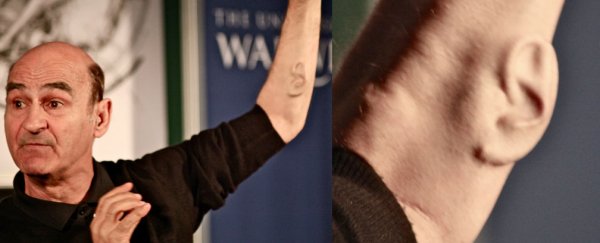An Australian performance artist is pushing the boundaries of body modification by growing an ear on his arm, which he eventually intends to connect to the Internet. Yes, it sounds a little crazy (sorry), but for those involved it's a serious long-term project fusing together science, art, and technology.
The artist, whose legal name is Stelarc (born: Stelios Arcadiou), first came up with the idea for Ear on Arm nearly 20 years ago, but it took him a good decade to find a medical team willing to perform the surgery, he told Courtney Bembridge at ABC. "The ear is pretty much now a part of my arm, it's fixed to my arm and it has its own blood supply," he said.
Despite its authentic, organic-looking appearance – albeit in an unusual location – Stelarc's extra ear is not the result of genetic organ cloning, which involves growing an organ before transplanting it into or onto a person's body. Rather, a team of surgeons conducted multiple surgeries to prepare and implant a prosthetic ear-shaped scaffold inside his arm, which his skin and tissue then grew around. You can see the implant procedure being performed in this clip:

Further work on the ear is planned to give it a more realistic three-dimensional appearance. The procedure will involve lifting the ear lobe up and out of the arm, while also incorporating some of Stelarc's own genetic material, as the artist explains on his web site:
"The ear lobe will most likely be formed by creating a cutaneous 'bag' that will be filled with adipo-derived stem cells and mature adipocytes. In other words the ear lobe would be partly grown using my own adult stem cells. Such a procedure is not legal in the US, so it will be done in Europe. It's still somewhat experimental with no guarantee that the stem cells will grow evenly and smoothly – but it does provide the opportunity of sculpturally growing more parts of the ear – and possibly resulting in a cauliflower ear!"
As the surgery video above shows, a working microphone was successfully implanted along with the ear scaffold, although it had to be subsequently removed due to an infection. Stelarc, who is also a professor with the Faculty of Humanities at Curtin University in Western Australia, intends to replace the microphone with a new wireless unit that will transmit audio to the Internet and be trackable by GPS.
"This ear is not for me, I've got two good ears to hear with," he said. "This ear is a remote listening device for people in other places. They'll be able to follow a conversation or hear the sounds of a concert, wherever I am, wherever you are."
"There won't be an on-off switch," he added. "If I'm not in a Wi-Fi hotspot or I switch off my home modem, then perhaps I'll be offline, but the idea actually is to try to keep the ear online all the time."
